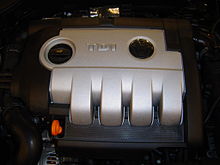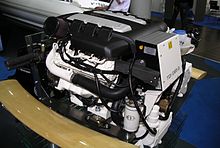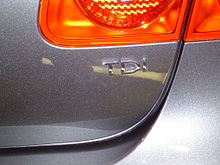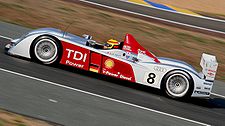- Turbocharged Direct Injection
-
 TDI badge
TDI badge Volkswagen Marine 3.0 litre V6 TDI 265-6 marine engine
Volkswagen Marine 3.0 litre V6 TDI 265-6 marine engine Volkswagen Group products which feature a TDI engine display a TDI badge
Volkswagen Group products which feature a TDI engine display a TDI badge
TDI or Turbocharged Direct Injection[1] is a design of turbodiesel engines, which feature turbocharging and cylinder-direct fuel injection,[1] developed and produced by Volkswagen Group.[2] These TDI engines are widely used in all mainstream Volkswagen Group marques of passenger cars and light commercial vehicles produced by the company[3] (particularly those sold in Europe). They are also used in marine engine - Volkswagen Marine,[4][5][6] and Volkswagen Industrial Motor[7] applications.
In many countries, TDI is a registered trademark of Volkswagen AG.[2]
Contents
Overview
The TDI engine uses direct injection,[1][2] where a fuel injector sprays atomised fuel directly into the main combustion chamber of each cylinder,[1][2] rather than the pre-combustion chamber prevalent in older diesels which used indirect injection. The engine also uses forced induction by way of a turbocharger[1][2] to increase the amount of air which is able to enter the engine cylinders,[2] and most TDI engines also feature an intercooler to lower the temperature (and therefore increase the density) of the 'charged', or compressed air from the turbo, thereby increasing the amount of fuel that can be injected and combusted.[1] These, in combination, allow for greater engine efficiency, and therefore greater power outputs[2] (from a more complete combustion process compared to indirect injection), while also decreasing emissions and providing more torque[2] than its non-turbo and non-direct injection petrol engined counterpart.
Similar technology has been used by other automotive companies, but "TDI" specifically refers to these Volkswagen Group engines. Naturally aspirated direct-injection diesel engines (those without a turbocharger) made by Volkswagen Group use the Suction Diesel Injection (SDI) label.
The reduced material volume of the direct injection diesel engine reduces heat losses, and thereby increases engine efficiency, at the expense of slightly increased combustion noise. A direct injection engine is also easier to start when cold, due to more efficient placing and usage of glowplugs.
Direct injection turbodiesel engines are frequent winners of various prizes in the International Engine of the Year Awards. In 1999 in particular, six out of twelve categories were won by direct injection engines: three were Volkswagen, two were BMW, and one Audi. Notably that year, the Volkswagen Group 1.2 TDI 3L beat the Toyota Prius to win "Best Fuel Economy" in its class.
History
The first passenger car to be powered by direct injection was the 1986 Fiat Croma 2.0 TD i.d. (Turbo Diesel iniezione diretta pump was developed by Bosch in accordance to the Fiat's engineers specifications). The first Volkswagen Group TDI engine was the Audi-developed 2.5 litre R5 TDI – an inline five-cylinder engine (R5), introduced in the Audi 100 in 1989 – and this variant is still used today in Volkswagen Marine applications. The TDI arrangement has been enhanced through various stages of evolution – by improving the efficiency of the turbocharger, increasing the pressure at which fuel can be injected, and more precisely timing when the injection of fuel takes place. There have been a few major 'generations', starting with what are known as "VE", and "VP" (German: VerteilerPumpe) engines, which use a distributor-type injection pump. In 2000, the Pumpe Düse (PD, variously translated "pump nozzle", "unit injector", "pump injector") TDI engine[1] began to appear in Europe, eventually coming to North America a few years later.
The Pumpe Düse design was a reaction to the development of high-pressure common rail fuel injection systems by competitors - an attempt by Volkswagen Group to create an in-house technology of comparable performance that would not require any royalties to be paid.[citation needed] While Pumpe Düse engines had a significantly higher injection pressure than older engines, they are slightly less refined when compared to the very latest common rail[citation needed] and, with the original solenoid-operated unit injectors, weren't able to control injection timing as precisely (a major factor in improving emissions).[citation needed] Some current PD TDI engines now use piezoelectric unit injectors, allowing far greater control of injection timing and fuel delivery. From the 2009 model year onwards, TDI engines using the common rail (CR) technique, again with piezoelectric injectors, are now used in various Volkswagen Group models.[1] The CR engines are available in many sizes, including 1.2, 1.6, 2.0, 2.7, 3.0, 4.2 and 6.0 litres, with outputs from 75PS to 500PS from these engines.
Motor racing
Audi R10 TDI LMP race car
A motor racing version of the common rail TDI engine made an impact in 2006 when it was used in the Le Mans Prototype (LMP) Audi R10 TDI, which won the 12 Hours of Sebring and 24 Hours of Le Mans, becoming the first diesel-powered car to win either of those endurance races. Fuel economy was a significant factor, as the car did not have to refuel as often as petrol engined race cars in the race. The car was fueled with a special synthetic V-Power diesel from Shell.
In 2007, SEAT – with the León Mk2 TDI at the Motorsport Arena Oschersleben in Germany – became the first manufacturer to win a round of the World Touring Car Championship (WTCC) series in a diesel car, only a month after announcing it will enter the FIA World Touring Car Championship with the León TDI. SEAT's success with the León TDI was continued, and resulted in winning consecutively 2008 World Touring Car Championship and 2009 World Touring Car Championship both titles (for drivers as well as for manufacturers).
in 2008, SEAT – with the León Mk2 TDI at Donnington Park in England - became the first manufacturer to win a round of the British Touring Car Championship (BTCC) in a diesel-powered car, Jason Plato won race 1 of the weekend and Darren Turner won race 3.
Fuel
TDI engines operate on diesel fuel (also known as petrodiesel), or B5, B20, or B99 biodiesel subject to manufacturers' prior approval.
In fuel efficiency, and clean emissions when run on biodiesel, or when converted vegetable oil (which should NOT be used on the later PD engines without prior conversion, since irreparable damage will result)[citation needed], TDI engines are among the best on the market.[citation needed] A 2007 Volkswagen Jetta Mk5 with a 1.9 TDI engine and a five-speed manual transmission, for example, achieves 5.2 litres per 100 kilometres (54 mpg-imp; 45 mpg-US) on the European combined-cycle test, while a six-speed direct-shift gearbox (DSG) automatic version reaches 5.9 litres per 100 kilometres (48 mpg-imp; 40 mpg-US).[8]
Newer TDI engines, with higher injection pressures, are less forgiving about poor-quality fuel than their 1980s ancestors. Volkswagen Group's warranty does not cover damage due to bad fuel (diesel or bio), and has in the past recommended that only mixtures up to 5% biodiesel (B5) be used. Volkswagen Group has recently permitted mixes up to B20, and has recommended B5 be used in place of 100% petroleum-based diesel because of biodiesel's improved lubricating properties.[9]
In North America, No. 2 diesel fuel is recommended, since it has a higher cetane number than No. 1 fuel, and has lower viscosity (better ability to flow) than heavier fuel oils. Some owners in North America, where cetane levels are generally poor (as low as 40), use additives, or premium diesel, to get cetane numbers closer to the standard levels found in the European market (at least 51) where the engine is designed. Improved cetane reduces emissions while improving performance, and may increase fuel economy.
New ultra low-sulfur petroleum-only diesel recipes cause seals to shrink[10] and can cause fuel pump failures in TDI engines; biodiesel blends are reported to prevent that failure.[11]
Lubricants
For many Volkswagen Group Diesel engines, Volkswagen AG requires that motor oil lubricants must only meet VW505.00, 505.01, 506.00, 506.01, or 507.00 officially approved standards.[12] 'Generic' oil standards such as the American Petroleum Institute 'API',[13] or European Automobile Manufacturers Association 'ACEA'[14] may not be recognised, nor approved by VW - so, depending upon the specific engine, oils bearing these generic approvals should not be used, except when the oil has also been granted one of the specific VW approvals. One known exception is the 1998 US market New Beetle TDI, where VW specified the use of oil bearing the API CD certification.[15] The API states that current CH-4 and CI-4 certified oils may be used in place of the older CD certified ones.[16]
Many formulations of motor oils from most brands are now "VW Approved" to the above standards. However, there does exist a few unapproved "off brands" that print the VW number on the label, effectively 'claiming' to meet the said standard, but hide in small type the word "recommended".[citation needed] Volkswagen AG only carries out in-house testing on motor oils to grant the necessary approvals; if Volkswagen AG, therefore, has not carried out such tests (or if a submitted oil has failed their tests), Volkswagen AG will not grant approval.[citation needed] Volkswagen Germany and Volkswagen of America freely publish up-to-date lists of currently approved oils on their respective websites, along with the technical resource, erWin.[17] Volkswagen AG does not permit any independent testing facility to grant their own VW standards.
See also
- SDI (engine)
- Diesel engine
- Turbodiesel
- Common rail
- Diesel automobile racing
References
- ^ a b c d e f g h "Technology - TDI - Super-efficient diesel engines for power with economy". Volkswagen.co.uk. Volkswagen UK. 2010. http://www.volkswagen.co.uk/technology/tdi. Retrieved 4 March 2010.
- ^ a b c d e f g h "Volkswagen AG - TDI Technical Glossary". Volkswagen.com. Volkswagen AG. http://www.volkswagen.com/vwcms/master_public/virtualmaster/en2/experience/innovation/technical_glossary/tdi.index.html. Retrieved 5 November 2009.
- ^ "TB 20 addendum - Technical Bulletin for Volkswagen Group timing belt renewal intervals". Gates.com. http://www.gates.com/europe/file_save_common.cfm?thispath=Europe%2Fdocuments_module&file=TB_020_addendum.pdf. Retrieved 4 November 2009.
- ^ "Volkswagen Marine > Engines <". www.vw-m.de. Volkswagen Group. 2009. http://www.vw-m.de/index.php?id=6&L=1. Retrieved 4 November 2009.
- ^ "Boat engines from Volkswagen Marine - Self-study programme M001 - Design and function" (PDF). www.vw-m.de. Volkswagen Marine. April 2001. http://www.vw-m.de/download.php?d=uploads/vwm/Self-study_programme_061214999999.pdf. Retrieved 18 February 2010.
- ^ "Boat engines from Volkswagen Marine - Self-study programme M002 - Design and Operation" (PDF). www.vw-m.de. Volkswagen Marine. August 2006. http://www.vw-m.de/download.php?d=uploads/vwm/Selbststudienprogramm_V6_engl_1_070115122148.pdf. Retrieved 18 February 2010.
- ^ "The SDI 1.9 Industrial Engine" (PDF), www.mi-uk.com (Volkswagen AG), March 2005, http://www.mi-uk.com/products/engines/downloads/sdi19industrial.pdf, retrieved 4 November 2009
- ^ "Jetta engines". Volkswagen Passenger Cars. http://www.volkswagen.co.uk/new_cars/jetta/engines. Retrieved 2007-06-04.[dead link]
- ^ "Biodiesel FAQ". http://forums.tdiclub.com/showthread.php?t=82466. Retrieved 2008-01-28.
- ^ "Technical bulletin: Fuel leaks from seals of vehicles using ultra low sulfur diesel" (PDF). Chevron. http://www.chevron.com/products/ourfuels/prodserv/fuels/documents/elastomer_chevron_tb_2005Aug.pdf. Retrieved 2008-01-28.
- ^ "Biodiesel Best Management Practices" (PDF). Virginia Clean Cities. June 2007. http://www.hrccc.org/images/Fuel_Quality_BMP_FINAL.pdf. Retrieved 2008-01-28.
- ^ "Volkswagen oil specifications". OilSpecifications.org. http://www.oilspecifications.org/volkswagen.php. Retrieved 19 February 2010.
- ^ "American Petroleum Institute". OilSpecifications.org. http://www.oilspecifications.org/api.php. Retrieved 19 February 2010.
- ^ "ACEA engine oil sequences". OilSpecifications.org. http://www.oilspecifications.org/acea.php. Retrieved 19 February 2010.
- ^ Volkswagen New Beetle Owners Manual, 1998
- ^ "API Engine Oil Guide". api.org. http://www.api.org/certifications/engineoil/pubs/upload/EngineOilGuide_March2010.pdf. Retrieved 14 November 2010.
- ^ "Approved oils - from erWin online". erWin.Volkswagen.de. Volkswagen Aktiengesellschaft. https://erwin.volkswagen.de/erwin/showApprovedOils.do. Retrieved 19 February 2010. (registration required)
External links
- VolkswagenAG.com - Volkswagen Group corporate website
- Polkowice (Poland) Plant Sustainability site - engine plant
- Audi-TDI-chronicle.com - official Audi history and timeline of the TDI engine
- TDI Curious - a Volkswagen Canada official blog exclusively dedicated to the TDI technology
- myTurboDiesel.com - a turbodiesel technical forum and "how to" page for Volkswagens
- TDI Club - A comprehensive source for all TDI information
- VW Golf TDI - Review and blog about a 2002 Volkswagen Golf TDI by Paul Vachier, an independent owner. Last update regarding the car's performance appears to be from 2005.
- ClubeTDI.com Portuguese Forum - Club TDI Portuguese - technical forum
Volkswagen Group Principal divisions and
subsidiariesAudi AG • (quattro GmbH) • Bentley Motors Ltd • Bugatti Automobiles S.A.S. • Lamborghini S.p.A. • SEAT, S.A. • Škoda Auto • Volkswagen Passenger CarsVolkswagen Commercial Vehicles • Scania AB (publ)InternationalVolkswagen Group of America, Inc. • Electronics Research Laboratory • Volkswagen do Brasil • Volkswagen Group China • Volkswagen Group in India • Volkswagen Group IrelandMajor interestsDefunct marques Executives
(former and current)Maj. Ivan Hirst (REME) (former Managing Director) → Heinrich Nordhoff (former Managing Director) → Dr Kurt Lotz (former CEO) → Dr Rudolf Leiding (former CEO) → Toni Schmücker (former CEO) → Dr Carl Hahn (Chairman Emeritus) → Ferdinand Piëch (Chairman of the Supervisory Board) → Dr Bernd Pischetsrieder (former CEO) → Prof Dr Martin Winterkorn (current Chairman of the Board of Management)See also List of Volkswagen Group factories • List of Volkswagen Group platformsEnginesTechnologiesfounder: Deutsche Arbeitsfront • Autostadt • Ehra-Lessien
Annual revenue €113.8 billion (2008) · Employees 369,928 (2008) · Stock symbol FWB: VOW3 · Website VolkswagenAG.comCategories:
€113.8 billion (2008) · Employees 369,928 (2008) · Stock symbol FWB: VOW3 · Website VolkswagenAG.comCategories:- Volkswagen engines
- Diesel engines
- Turbochargers
- Engine technology
- Engine fuel system technology
- Fuel injection systems
- Marine engines
Wikimedia Foundation. 2010.




